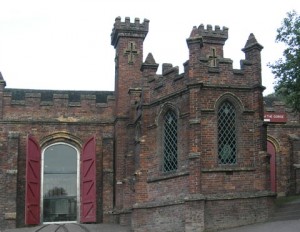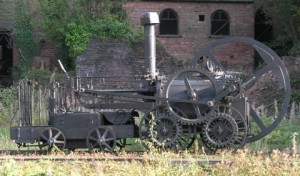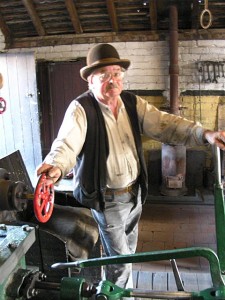Ironbridge Gorge Museums
Ironbridge, near Telford in Shropshire, is rightly regarded as one of the foundations of the Industrial Revolution. Here in 1707, Abraham Darby perfected (and patented) a method of smelting iron ore using coke.
Previously, the process required charcoal, which takes a great deal of time and effort to produce, first growing the trees (!), then burning the wood under the right conditions. As a result, the amount of iron that could be smelted was limited by the supply of charcoal. The discovery of a means of using coke – which is derived from coal – meant that iron could be produced as quickly as the coal could be mined. This enabled the Industrial Revolution to take off.
In 1779 the great Iron Bridge across the Severn, after which the town is named, was built by Abraham Darby III. It was the first cast-iron bridge in the world.
Today, the industry that characterised the area for hundreds of years is largely silent, but in its place is a collection of nearly a dozen different museums and attractions that help us to understand our industrial heritage. You can find out more about them here. In 1986 the Gorge was one of the first seven UK sites awarded World Heritage Site status by UNESCO.

The Museum of the Gorge is housed in a converted Gothic-style riverside warehouse, where goods where stored prior to shipping down the Severn.
To see all the major locations will take you more than a day, particularly as a result of the extensiveness of Blists Hill Victorian Town. However, I suggest you start at the Museum of the Gorge, which boasts one of the most detailed dioramas I’ve ever seen, in this case of the stretch of the Severn and the enormous collection of industrial activities carried out here from mediæval times onwards.
In addition, you might like to take in the Coalbrookdale Museum of Iron. However the most extensive location to visit in the area is Blists Hill Victorian Town. Based around the site of an old brick works, the town consists of buildings either restored, relocated or specially built following detailed research.
You enter the town via a very impressive (and recent) audiovisual presentation which highlights the region’s industrial heritage, and then you’re on the main street, where the first building is a Lloyds Bank. Here you can exchange modern money for traditional pre-1971 £.s.d. that you can use to buy items in the shops on the site (they also take modern money, unlike the Kentwell Hall’s Tudor re-enactments, where beyond the “time tunnel”, all transactions have to be done with the traditional coinage).

Replica of Richard Trevithick’s locally-built Pen-y-Darren locomotive of 1809
There are working steam engines, including one used to raise and lower a mine cage and a replica of Richard Trevithick’s 1802 Pen-y-Darren locomotive. There are a couple of very impressive beam engines originally used to blow air into blast furnaces, but regrettably these will never steam again and are demonstrated by driving with an electric motor.

The operator of the mineshaft winding gear steam engine
Costumed staff are on hand to describe the businesses, shops and industry of the Victorian era and I was very tempted to turn up in costume – though I was not sure how they would react. Some places love you to do that, while others (notably Kentwell) abhor it, as you might be mistaken for staff and, not knowing the back-story, might let them down (at Kentwell the back-story is so detailed that this is a real possibility). Beamish, I seem to recall, lets you turn up in costume and they give you a special tag (suitably printed in letterpress fonts of the period, presumably in their print shop) to indicate that you’re a “Visitor”.
Indeed, the obvious comparison with Blists Hill is Beamish, and there is apparently a little rivalry between the two sites, it was hinted, but in fact the two, while there is some obvious overlap, have some significant differences – the money at Blists Hill and the trams at Beamish for example. At Blists Hill, you get around on foot or by horse-drawn wagon.
Blists Hill has a wide selection of shops, sometimes producing and selling items; there are also some performances by a pair of actors who present hilarious excerpts from Shakespeare (with the help of the audience) and there are music-hall songs in the pub from time to time.
I did not take a great deal of video, but here is one extract. Down the bottom of the town there’s a Victorian funfair, including a merry-go-round, which originally, one presumes, would have been driven by a steam traction engine. There’s a nice little Pell organ on this one, playing various medleys of tunes of the era, of which you can hear a sample below.


